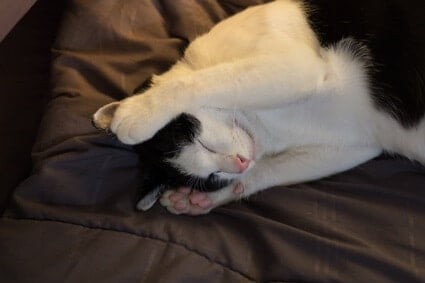Cats spend so much time napping that it’s natural to assume they are sleeping peacefully. This makes it unnerving to watch a cat seemingly react to a dream. A sleeping cat may cry, growl, hiss, and swipe its claws while asleep.
Cats enter REM sleep while dozing, so cats do dream. This makes it almost certain that cats can endure night terrors. It is believed that cats’ dreams are re-enactments of the events of a day. If the cat had a bad or frightening experience, it may be re-lived after dark.
While it can be upsetting to watch a cat experiencing a nightmare, you should never wake it up. Sleep, regardless of dreams, is pivotal to felines. If a dream spooks a cat, you’ll likely be clawed or bitten. Leave your cat to come around naturally, offering reassurance when it wakes.
Do Cats Dream When They Sleep?
The average cat spends around 16 hours a day sleeping. It is also believed that cats experience dreams. While this is impossible to confirm, plenty of evidence suggest that cats dream while dozing.
Cell Reports claims that human and mammalian brains share a similar structure in the hippocampus. This is the part of the brain that makes new memories. The hippocampus works in tandem with the amygdala, ensuring that important new information is retained.
Whatever a cat senses and feels during a day is processed by the hippocampus. The cat’s brain will decide what information is essential, and what can be discarded.
Invariably, at least some of these memories will be processed while the cat naps. This, as per The Journal of Sleep Research, is why sleeping cats display oneiric behaviors (such as twitching and moving). These actions are typical of REM sleep.

REM Sleep vs. Deep Sleep
REM sleep and deep sleep are the two core cycles of a cat’s sleep pattern. Each of them is equally important but impact a feline differently.
Deep sleep is as restful as it sounds. If a cat is in deep sleep, it will not dream. The cat’s breathing will be slow and steady, and the body will remain completely still. Deep sleep is important, as it enables feline muscles to repair themselves from a day’s exertions.
Rapid Eye Movement (REM) sleep is when dreams occur. This is because, during REM sleep, the cat’s brain remains active. The hippocampus is busily sifting through memories during this stage of sleep. Signs that your cat is in REM sleep, and thus dreaming, include:
- Pupils rapidly darting behind closed eyelids
- Moving the head, as though watching prey
- Faster, more labored breathing
- Swiping paws
- Verbalizing
REM sleep may not always look peaceful, but it is vital. Without dreams, your cat cannot maintain or dismiss memories. This will eventually lead to the cat becoming overwhelmed. REM sleep is every bit as important to your cat’s brain as deep sleep is to its body.
Cats do not follow a strict routine of REM sleep vs. deep sleep. Your cat drifts in and out of both cycles, possibly multiple times, during the same slumber.
Age will dictate how much deep sleep the cat needs. Tired or damaged joints and muscles need more reparation. This means that senior cats will spend more time in deep sleep, and less in REM.
What Do Cats Dream About?
It is commonly believed that cat dreams involve re-living events of the recent past. On average, a cat retains memories for around 16 hours. Until the hippocampus has fully processed these memories, they will remain in a cat’s mind.
If your cat purrs and moves in its sleep, it is likely re-enacting memories from the day. If your cat looks peaceful and arches its back, it may be dreaming of being petted. Waving paws and chirping suggest the cat is dreaming of an earlier hunt or play session.
Senior felines typically fall into deep sleep easier, and more often, than younger counterparts. This means that older cats also seemingly dream less frequently. This makes sense. Senior felines are more sedentary and will have fewer new adventures to recall.
Do Cats Have Nightmares?
Sometimes, a cat will seem distressed in its sleep. It may cry out, or swipe claws while sleeping. This is because cats do not only recall positive experiences. They also need to process bad memories, often through dreams. This suggests that cats have nightmares.
In some respects, this is a positive experience. It means the memory will be purged from the cat’s mind. By the time the cat wakes up, it should have moved on. This is obviously better than the cat continuing to live in fear.
All the same, a cat having a nightmare should be watched closely and handled with care. Just as pleasant dreams cause cats to re-enact movements, so will nightmares. Your cat will thrash, claw and bite in its sleep. Stay out of physical range.
Dealing with Night Terrors in Cats
Watching a cat have a nightmare is a horrible experience. As a pet owner, you dedicate yourself to making your cat as comfortable as possible. There is nothing you can do help a sleeping cat, though.
It is critical that you do not wake your cat up, no matter how distressed it appears to be. The cat will already be disoriented from its dream. It may also struggle to differentiate between dreams and reality for a few moments.
The upshot is your cat will be terrified, and frightened cats are aggressive. Your cat will likely attack with teeth and claws. This is just an instinct.
In addition, a cat having a nightmare will already have a racing heart. Waking the cat unexpectedly will cause a further jolt. This can be dangerous in senior cats, leading to palpitations and even cardiac arrest.
Watch your cat and ensure it does not hurt itself while dreaming. A cat having a night terror will jerk and twitch. This means it could fall off a sofa or wherever it is perched. These movements may also wake a cat suddenly, again leaving you at risk. Stay close enough to tend to your cat, but far enough away to be safe.
Once you have found an appropriate distance, you can start to tend to your cat’s needs. Start by offering gentle reassurance. If your cat wakes up, follow this by aiding your cat’s recovery. You should make your cat as comfortable as possible after a nightmare.
Reassurance
A cat in REM sleep will be obviously be asleep. The cat will not quite be dead to the world, though. This means that you can offer some measure of comfort to your cat while it dozes.
Say your cat’s name in a soft, gentle voice. Intersperse this with soothing commands and assurances, like, “it’s OK.” This will seep through to your sleeping cat to an extent. The familiarity of your voice – and association with the safety you provide – will reassure the cat.
Appeal to your sleeping cat’s sense of smell, too. Lay a familiar-scented item close to your cat’s nose. A favored blanket or cushion will be fine. Again, this will register with the cat. These comforting sensations may redirect the brain to recall something more pleasant.
Keep doing this until your cat wakes up. When it does so, do not get straight in your cat’s face. Take a step back, call your cat’s name, and let it approach you. At this point, you can help your cat recover from its subconscious ordeal.
Recovery
When your cat is awake, you can help it return to its old self. Let your cat call the shots. Do not immediately scoop it up and start offering petting. It may take your cat a while to come around from a frightening dream.
Your cat wants attention. Reassure your cat that it is safe and loved. You may also want to offer a treat and playtime at this stage. Ensure your cat makes new, positive memories as quickly as possible.
Get your cat nice and warm, too. As explained by Science, sleeping cats experience a drop in body temperature. A frightening dream may have also placed a cat into low-level shock. This twin impact could leave your cat’s temperature dangerously low. Offer a blanket or a hot water bottle. If nothing else, this additional warmth provides comfort to a cat.
Finally, if your cat wants to do back to sleep, allow it to do so. The cat has clearly been comforted appropriately. Sleep deprivation will cause anxiety, which will in turn lead to more night terrors.
Preventing Night Terrors in Cats
We have no reason to believe that cats dream about things that have not transpired. Cat brains respond to facts and events, not imagined possibilities. In addition, cats do not watch horror films or read scary stories. They should not be exposed to or remember frightening images.
This means, in theory, it should be simple to prevent your cat from having night terrors. Just provide it with the most idyllic life imaginable. If your cat never has a bad experience, it can never dream about it.
Unfortunately, this is not the case. Just as with humans, feline dreams can contain random images. During REM sleep, a cat’s brain may uncover previous memories, stored because they were considered critical.
A cat’s brain is unlikely to piece these together into a narrative. The image of a striking snake, though, will provoke immediate terror. Likewise, a cat that experienced mistreatment and trauma may recall this during sleep.
You cannot take a chance on your cat’s past. Consider common fears and stressors that impact domesticated cats, though. If you prevent your cat from experiencing these, it is less likely to suffer night terrors.
Abandonment
Do not be fooled by a cat’s cool exterior. Your cat is not indifferent to your presence. If you abandoned your cat, it would miss you.
While cats will not imagine a fictional abandonment scenario, it may recall being left alone. A cat with an insecure bond may find your working hours away from the home frightening.
The easiest way to keep your cat calm is by establishing a set routine. If your cat knows what to expect every day, it knows that you will return every day.
If you feed and play with your cat upon waking, it will come to expect this. You can also establish the same routine at night, when you come home. Time this appropriately and your cat’s last memories of the day will be positive. This will likelier result in pleasant dreams.

Physical Pain
Cats have excellent poker faces, rarely revealing when they are in pain. A senior cat, in particular, may be masking physical discomfort or illness.
While the cat can hide this during its waking hours, night terrors may reveal a struggle. Your cat will dream about the pain and react accordingly.
Of course, it’s also possible that your cat is re-living a single, painful experience. Somebody may have stepped on the cat’s tail, or it could have experienced an impact injury. These bad dreams will typically be short and easily resolved, though.
If your cat is having constant nightmares, take your cat for a check-up. You should be doing this annually anyway, ideally twice a year for older cats. General tests will uncover any potential illnesses or conditions that are causing your cat physical distress.
Conflict and Bullying
If you have a multi-cat household, ensure that the dreaming cat is not being bullied. Cats that live together often end up deferring to a single, dominant feline. This cat may end up making life miserable for others.
The same also applies to other pets in the house. If you have a dog, ensure it is not chasing your cat. The dog may just be playing, but the cat does not know this. It will likely be terrified, especially if there is a size discrepancy between the animals.
If your cat wanders outside, it may be coming into conflict with neighborhood pets or wildlife. Try keeping the cat indoors for a few days, if it will accept this. If the night terrors cease, the root cause will be apparent.
Frightening Experiences
Stress and anxiety are often linked to night terrors in humans. The same applies to cats. An anxious cat is likelier to re-live previous, otherwise forgotten, experiences while sleeping. Many experiences can frighten a cat and provoke stress, including:
- Loud, unexpected noises (cars backfiring or shouted conversations)
- Scolding for unwanted behaviors
- Getting stuck in a tree
- Being left alone unexpectedly for a prolonged period of time
- Not being fed at an expected time
- Unsanitary living conditions
- Boredom
Avoid exposure to these as much as possible. Some will be easier to circumvent than others. What is most important is that your cat does not suffer prolonged exposure.
The more stressors a cat experiences in everyday life, the more skittish it will become. This, in turn, will lead to more nightmares. These will take a significant toll on your cat’s quality of life.
Cats appear to dream, making it likely that cats experience occasional night terrors. Thankfully senior cats are less likely to experience this, as older felines sleep deeper. Be vigilant about comforting a cat that is enduring a nightmare. Just do so from a safe distance.


Is it possible that medications such as Prazosin could cause a cat to scream loudly in their sleep, without moving or shaking at all? Our cat had an episode like this tonite that literally scared the bejebus out of us, we had never seen this before so we tried unsucessfully to wake him up, he finally came around, eventually jumping down and pooping under the coffee table which he never does. Finally after a half hour or so, he ate some wet food and went outside in our well-fenced backyard, came back in and went back to sleep in the same chair he had the episode in. He literally cried loudly in his sleep for a good minute, without moving at all. Sure hope this doesn’t happen again.